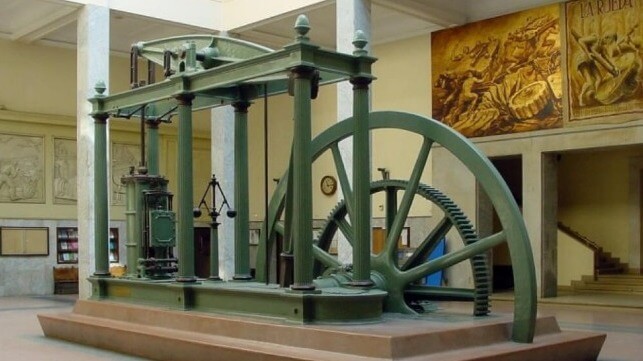Market Forces Reducing Vehicle Carbon Emissions

Several present-day governments seek to use legislation to reduce atmospheric carbon emissions from transportation industry vehicles. However, the greatest reductions in vehicle carbon emissions occurred over a prolonged period of time that precedes government action aimed at reducing such emissions.
Introduction
The history of heat-driven engines traces back to 1712 when Scottish inventor Thomas Newcomen developed the first fire-powered steam engine. A piston inside a cylinder would move to maximum volume when steam pressure pushed a spray of cold water into the cylinder to cool air and cause its pressure to drop to below that of atmospheric pressure. Atmospheric pressure drove the massive piston inward, to minimum cylinder volume. These fire engines used dried wood, which is mainly carbon, as fuel. James Watt improved on Newcomen’s concept when he developed the first wood-fired high-pressure steam engine in 1769.
By early 1800s, wood-fired steam engines provided propulsive power for early railway locomotives and boats that operated on comparatively short voyages between coastal cities and along navigable rivers. The early transportation sector steam engines delivered a calculated energy efficiency of around 4% and emitted a generous quantity of carbon dioxide into the atmosphere. Later improvements to steam engines included the development of super-heaters as well as compounded expansion of steam involving high-pressure and low-pressure cylinders, with reheating of steam prior to entering the low-pressure cylinder. Use of coal as fuel greatly increased steam temperature and engine efficiency.
Efficiency Improvements
As coal replaced wood as the fuel to operate boilers, the hotter combustion temperature of coal led to the development of higher-pressure steam engines that operated at higher levels of thermal efficiency. It became possible to develop triple-expansion steam piston engines for maritime propulsion, with reheat of steam moving between high-pressure and intermediate-pressure cylinders, as well as between between intermediate-pressure and low-pressure cylinders. By early 1900s, compact steam turbine engines with efficiency approaching 20% began to appear on large ships to drive propellers either through gear reduction or through electrical generators and electric motors.
As engine efficiency gradually improved using either wood of coal for fuel, the amount of atmospheric carbon emissions per 100-horsepower declined. By 1930s, small diesel fuel engines that operated at over 30% thermal efficiency began to provide propulsion for small boats that sailed along navigable inland waterways. Some manufacturers used precedent from steam piston engines to develop large-displacement, slow turning diesel engines capable of driving propellers of larger vessels. Diesel grades between C10H20 and C15H28 contain hydrogen that reacts with oxygen during combustion, in turn further reducing atmospheric carbon emissions over wood or coal powered boats.
Modern Engine Efficiency
The maritime sector operates the world’s most thermally efficient, large-scale modern piston engine that converts diesel fuel to propulsive power at 50% efficiency, with scope to raise efficiency by installing a “bottom-cycle” engine that would convert engine exhaust heat to usable power. Large-scale gas turbine engines that deliver more than double of the output of the largest maritime piston engines, operate at near 50% thermal efficiency burning any of variety of combustible fuels and sustain the operation of a “bottom-cycle” engine to further increase engine efficiency.
Electric trains move massive amounts of freight and passengers using locomotives that draw power from overhead power cables, including electric power produced by coal-fired powered stations that operate at up to 50% efficiency. The same power stations may also provide electric power to recharge electric vehicles and to produce hydrogen at 70% efficiency, required for the operation of solid-state fuel cells that operate at 60% efficiency and electric motors at 90% efficiency. From coal-fired power station to a powered axle or propeller, a hydrogen fuel cell vehicle can incur an overall energy efficiency of below 20%.
Cheap Fuel
During the early 1940s, several governments rationed gasoline for civilian populations. In response, several industries developed methods by which to develop alternative fuel for the civilian market. In the USA when gasoline (C8H18) sold at 18-cents per gallon, it was possible to pump a gallon of propane (C3H8) into a high-pressure tank at a cost of 3-cents per gallon. Propane was among the fuels used in the engines of some farm tractors and some city transport buses - and due to its chemistry, it emitted lower carbon emissions than gasoline or diesel-powered engines.
Carbon-free Fuel
An electrical current applied to saline water separates the hydrogen from the oxygen. Dating back into the late 1970s, tests were undertaken using hydrogen as fuel for modified internal combustion engines that emitted zero carbon emissions. Subsequent research of a later time focused on the development of fuel cells that bonded hydrogen to oxygen to produce electric power without combustion, releasing water as the byproduct. In more recent years, engine research has focused on adapting large-scale, internal combustion piston engines1 to operate on ammonia (NH3) and reduce carbon emissions into the atmosphere.
Plans are now underway to construct a container ship to be powered by ammonia2 and tentatively scheduled to enter commercial service by 2026. It is also possible to adapt internal combustion engines intended for maritime propulsion and even commercial aircraft to utilize hydrogen as fuel.
Given that several carbon-free propulsive systems incur lower energy storage density, the maritime sector would need to evaluate future operation of mega-size tug-barges in extended-distance ocean service. Super-size tugs powered by carbon-free propulsion technologies would initially operate along inland waterways, on North America’s Great Lakes and in domestic coastal service.
Top image: A Watt double-acting steam engine built in 1832 (Nicolas Perez / CC BY SA 3.0)
The opinions expressed herein are the author's and not necessarily those of The Maritime Executive.
